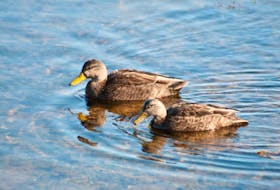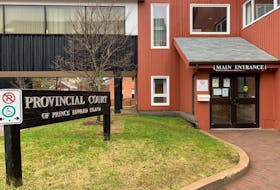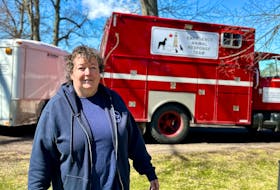The Vikings first set foot at L’Anse aux Meadows 1,000 years ago and stayed only for a few years, but one modern day man has walked that walk for pretty much all of his life and now lives to tell the tales of those bygone neighbours.
For Clayton Colbourne, who was born and raised on Beak Point, just next to this historic Viking settlement site in Newfoundland, the strange mounds on which he played as a child were just part and parcel of the backyard fun for him and his 10 siblings.
Now it’s part of his job as a Parks Canada interpreter to regale visitors from around the world with information about those mounds and more at this national historic site, with some stories of his own life thrown in for colourful commentary.
FACT SHEET ON L'ANSE AUX MEADOWS
“These mounds that were discovered in the 1960s by the Norwegian historian Helge Ingstad and his archeologist wife Anne Stine Ingstad were visible to us all along, but we didn’t know it was Viking, we just assumed it was Indian.
“But you could see those low grass-covered mounds in the terrain and of course that was one of our playgrounds when we were kids. We played a lot of cowboys and Indians as a matter of course; we should have been playing Vikings,” laughs Colbourne between one of his many daily tours at L’Anse aux Meadows, which is in plain view of the small cluster of white clapboard houses on a sand spit on which he and other members of his family still live.
With the constant flow of summer tourist traffic, which arrives by the tour busload by times, it’s hard to imagine how different this bustling beehive of activity is from the 1950s when Colbourne and his siblings raced among the mounds.
“When I was a kid there were no roads, there was no electricity and the only contact we had really with the outside was when the ships arrived to bring supplies. Of course they’d take away salt cod fish because my folks were fishermen,” he said.
In the 1960s things changed dramatically for this tiny remote Newfoundland hamlet with the Ingstads’ archeological discovery of the Viking settlement.
“The road came because of this discovery. There was no real reason to put a road in prior to the discovery of the Viking site because everything was by sea,” Colbourne says.
Other than children romping and roaming about the ruins, the only activity on the site in recent years prior to that was local fisherman George Decker’s harvesting of the wild grass to feed his small cache of livestock.
When the Ingstads arrived in 1960 looking for a Viking site, Decker led them directly to the mounds, which were as familiar to him as the back of his hand.
That led to a flurry of archeological excavation activity and international attention the likes of which L’Anse aux Meadows’ living occupants could never have anticipated.
“At first it was a bit strange for us, being isolated and such to have strangers in our backyards, so it took a little bit of getting used to I must admit,” Colbourne says.
“But we didn’t know the importance of archeological work whatsoever. Our greatest ambition was to see how much fish we could (harvest) from those waters.
“But as time went on, we kids, in particular, used to watch them uncover sites most every day. We got to know them and a couple of them entertained us quite well because my mother used to bake bread for them as a matter of fact so they spent a lot of time at our house. They became good friends of ours over the years.”
The development of L’Anse aux Meadows as a tourist destination was another unforeseen change.
“Nobody could foresee that this would happen in our wildest dreams but here we are,” said Colbourne, who began working for Parks Canada in 1973 in various capacities, including helping with the building of the recreations of the onsite Viking sod structures in 1978.
“When we got them finished up in 1979 they asked if I would like to stay on and explain the construction of the buildings to visitors and start the fire in the morning – it was all wood fires at that time and of course I knew all about building fires – so I’ve had this job since 1980. So I attribute it to luck, not education,” he adds with a smile.
He says that education came after the fact as more and more people from all over the world found their way to this rural Newfoundland Parks Canada site, just as Leif Erikson and his stalwart crew did back in their ancient Viking day.
And having lived in this spot all his life, he can see why these experienced explorers chose it as their overwintering site.
“The currents loop right into the bay here and those explorers had a reputation of following the currents. . . . It’s strategically located so they could come here consistently,” Colbourne says, his mind’s eye envisioning those things through a Norseman’s eye.
“Another reason I guess is because the land is low and they could pull their boats up here quite easily. We found actual proof that they repaired their boats right on this site and they need a place where the land is quite low so they can get their boats up quite easily of course.”
And, of course, always top of the list for any self-respecting, hungry ninth century Viking explorer’s must-have list is food and plenty of it.
“Another reason could have been the fish in that brook. Believe it or not, we used to catch salmon with our hands when I was a kid. My mom is 87 years old and was born in L’Anse aux Meadows. She said when she was a little girl the fishermen caught salmon and trout in the brook by the wheelbarrow load,” Colbourne says.
“There was whalebone found in the fire places, seal bone and fish vertebra of many kinds. There are a dozen varieties of edible berries and of course they would have gathered every one of them, as do I. So it’s not a bad place to stay awhile.”
Although the Vikings left this settlement behind a millennium ago, after 64 years of L’Anse aux Meadow living, Colbourne plans to stay awhile longer himself.
“Why did I stay? Love. I love the lifestyle in this region. I guess I take after Mom, because Mom is 87 years old and she’s lived here all of her life. I couldn’t live anywhere else.”
The Vikings first set foot at L’Anse aux Meadows 1,000 years ago and stayed only for a few years, but one modern day man has walked that walk for pretty much all of his life and now lives to tell the tales of those bygone neighbours.
For Clayton Colbourne, who was born and raised on Beak Point, just next to this historic Viking settlement site in Newfoundland, the strange mounds on which he played as a child were just part and parcel of the backyard fun for him and his 10 siblings.
Now it’s part of his job as a Parks Canada interpreter to regale visitors from around the world with information about those mounds and more at this national historic site, with some stories of his own life thrown in for colourful commentary.
FACT SHEET ON L'ANSE AUX MEADOWS
“These mounds that were discovered in the 1960s by the Norwegian historian Helge Ingstad and his archeologist wife Anne Stine Ingstad were visible to us all along, but we didn’t know it was Viking, we just assumed it was Indian.
“But you could see those low grass-covered mounds in the terrain and of course that was one of our playgrounds when we were kids. We played a lot of cowboys and Indians as a matter of course; we should have been playing Vikings,” laughs Colbourne between one of his many daily tours at L’Anse aux Meadows, which is in plain view of the small cluster of white clapboard houses on a sand spit on which he and other members of his family still live.
With the constant flow of summer tourist traffic, which arrives by the tour busload by times, it’s hard to imagine how different this bustling beehive of activity is from the 1950s when Colbourne and his siblings raced among the mounds.
“When I was a kid there were no roads, there was no electricity and the only contact we had really with the outside was when the ships arrived to bring supplies. Of course they’d take away salt cod fish because my folks were fishermen,” he said.
In the 1960s things changed dramatically for this tiny remote Newfoundland hamlet with the Ingstads’ archeological discovery of the Viking settlement.
“The road came because of this discovery. There was no real reason to put a road in prior to the discovery of the Viking site because everything was by sea,” Colbourne says.
Other than children romping and roaming about the ruins, the only activity on the site in recent years prior to that was local fisherman George Decker’s harvesting of the wild grass to feed his small cache of livestock.
When the Ingstads arrived in 1960 looking for a Viking site, Decker led them directly to the mounds, which were as familiar to him as the back of his hand.
That led to a flurry of archeological excavation activity and international attention the likes of which L’Anse aux Meadows’ living occupants could never have anticipated.
“At first it was a bit strange for us, being isolated and such to have strangers in our backyards, so it took a little bit of getting used to I must admit,” Colbourne says.
“But we didn’t know the importance of archeological work whatsoever. Our greatest ambition was to see how much fish we could (harvest) from those waters.
“But as time went on, we kids, in particular, used to watch them uncover sites most every day. We got to know them and a couple of them entertained us quite well because my mother used to bake bread for them as a matter of fact so they spent a lot of time at our house. They became good friends of ours over the years.”
The development of L’Anse aux Meadows as a tourist destination was another unforeseen change.
“Nobody could foresee that this would happen in our wildest dreams but here we are,” said Colbourne, who began working for Parks Canada in 1973 in various capacities, including helping with the building of the recreations of the onsite Viking sod structures in 1978.
“When we got them finished up in 1979 they asked if I would like to stay on and explain the construction of the buildings to visitors and start the fire in the morning – it was all wood fires at that time and of course I knew all about building fires – so I’ve had this job since 1980. So I attribute it to luck, not education,” he adds with a smile.
He says that education came after the fact as more and more people from all over the world found their way to this rural Newfoundland Parks Canada site, just as Leif Erikson and his stalwart crew did back in their ancient Viking day.
And having lived in this spot all his life, he can see why these experienced explorers chose it as their overwintering site.
“The currents loop right into the bay here and those explorers had a reputation of following the currents. . . . It’s strategically located so they could come here consistently,” Colbourne says, his mind’s eye envisioning those things through a Norseman’s eye.
“Another reason I guess is because the land is low and they could pull their boats up here quite easily. We found actual proof that they repaired their boats right on this site and they need a place where the land is quite low so they can get their boats up quite easily of course.”
And, of course, always top of the list for any self-respecting, hungry ninth century Viking explorer’s must-have list is food and plenty of it.
“Another reason could have been the fish in that brook. Believe it or not, we used to catch salmon with our hands when I was a kid. My mom is 87 years old and was born in L’Anse aux Meadows. She said when she was a little girl the fishermen caught salmon and trout in the brook by the wheelbarrow load,” Colbourne says.
“There was whalebone found in the fire places, seal bone and fish vertebra of many kinds. There are a dozen varieties of edible berries and of course they would have gathered every one of them, as do I. So it’s not a bad place to stay awhile.”
Although the Vikings left this settlement behind a millennium ago, after 64 years of L’Anse aux Meadow living, Colbourne plans to stay awhile longer himself.
“Why did I stay? Love. I love the lifestyle in this region. I guess I take after Mom, because Mom is 87 years old and she’s lived here all of her life. I couldn’t live anywhere else.”
• In the past four to five thousand years, many people have lived at L’Anse aux Meadows, N.L.; some stayed longer than others. Among these people was a small group of Norse sailors. The remains of their camp, discovered in 1960 by Helge and Anne Stine Ingstad, is the oldest known European settlement of the New World.
• From now until July 31, L’Anse aux Meadows is the site of the Westward Viking Festival — A real Taste of Vinland.
• A news release urges people to come experience life as a Viking by immersing yourself in every day Viking life in the Viking encampment program, or take in one of the many site programs of Viking age skills. For information call 709-623-2608.








